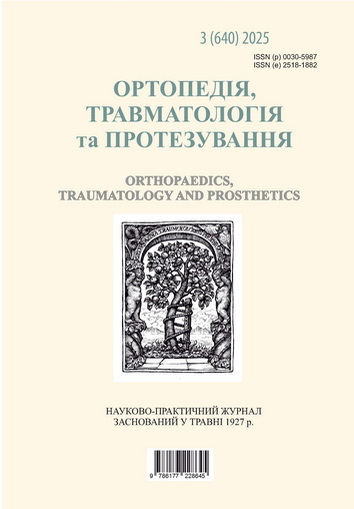PATELLAR TENDINOPATHY AFTER ARTHROSCOPIC MENISCUS RESECTION, WITH «ANTERIOR KNEE PAIN» SYNDROME
DOI:
https://doi.org/10.15674/0030-59872025375-83Keywords:
Knee tendinopathy, knee arthroscopy, rehabilitation, anterior knee pain syndromeAbstract
Patellar tendinopathy is a common problem in patients after arthroscopic interventions, accompanied by chronic pain and limitations in knee joint function. The purpose of the study was to analyze the dynamics of clinical and functional parameters in patients with patellar tendinopathy within 3 months after surgery and standard rehabilitation. Methods. The study involved 196 patients with diagnosed patellar tendinopathy (29.1 %) who underwent arthroscopic meniscus resection. All patients received a standard course of rehabilitation measures. Control was performed after 2 weeks, 6 weeks and 3 months, assessing the level of pain on the VAS scale, functional capacity on the KSS and AKPS scales, as well as quality of life on the SF- 36 scale. Results. It was found that in patients who underwent comprehensive rehabilitation, the level of pain decreased from 6.9 ± 1.0 to (2.2 ± 0.6) points (68.12 % decrease). According to the AKPS scale, functional capabilities increased from 62 ± 4.4 to (64 ± 1.6) points (an increase of 3.2 %). The restoration of motor and psychological functions contributed to a significant improvement in the quality of life: the SF-36 score increased to (78.2 ± 4.6) points, which is 15% more than the initial score and confirms the effectiveness of integrated approaches. Conclusions. Analysis of the results shows that in patients who developed patellar tendinopathy after arthroscopic meniscus resection, even 3 months after surgery, the level of functional ability and quality of life remained lower than before surgery. Overall, physical functioning decreased by 6.7 % (from 75 to 70 points). Role limitations related to physical health decreased from 65 to 22. Psychological indicators also improved: emotional well-being rose from 50 to 75, although it remained below the preoperative level. Social functioning decreased from 88 to 78, a decrease of 11.36 %. Pain levels decreased by 27.3 % (from 55 to 70), but pain sensations remain pronounced. Thus, most indicators failed to reach preoperative levels, although significant progress in recovery and functionality has been observed.
Downloads
How to Cite
Issue
Section
License
Copyright (c) 2025 Аndrii Gerasymenko, Olha Yurik, Sergii Gerasymenko, Аndrii Babko, Dmytro Poluliah, Vadym Hromadskyi

This work is licensed under a Creative Commons Attribution 4.0 International License.
The authors retain the right of authorship of their manuscript and pass the journal the right of the first publication of this article, which automatically become available from the date of publication under the terms of Creative Commons Attribution License, which allows others to freely distribute the published manuscript with mandatory linking to authors of the original research and the first publication of this one in this journal.
Authors have the right to enter into a separate supplemental agreement on the additional non-exclusive distribution of manuscript in the form in which it was published by the journal (i.e. to put work in electronic storage of an institution or publish as a part of the book) while maintaining the reference to the first publication of the manuscript in this journal.
The editorial policy of the journal allows authors and encourages manuscript accommodation online (i.e. in storage of an institution or on the personal websites) as before submission of the manuscript to the editorial office, and during its editorial processing because it contributes to productive scientific discussion and positively affects the efficiency and dynamics of the published manuscript citation (see The Effect of Open Access).














